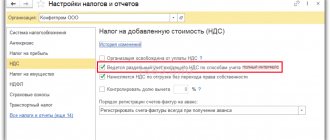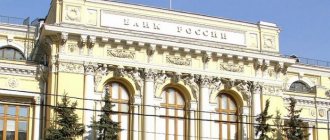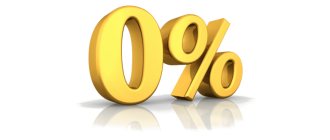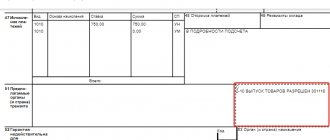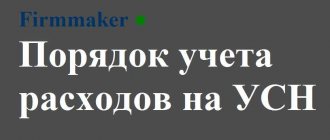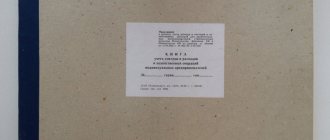Home / Taxes / What is VAT and when does it increase to 20 percent? / VAT object
Back
Published: December 28, 2017
Reading time: 6 min
0
431
According to Russian legislation, today three VAT percentage rates are applied in the sale of goods and services - , 10% and 18%, each of which has its own regulated criteria for the distribution of validity.
- List of goods for which a VAT rate of 10% applies
- Procedure for confirming 10% VAT Where can I find the code for Russian and imported goods?
- For medical products
A rate of 10% is the most convenient when conducting operations with the sale of goods on the domestic market. In this regard, the Tax Code of the Russian Federation gives clear explanations: what goods are included in the group of distribution of the 10% VAT rate, how the right to use this rate is confirmed, what documents should be prepared.
Who needs confirmation of VAT at a rate of 10%
Russian companies and individual entrepreneurs that import, supply and sell products are required to pay VAT. Value added tax is applied when using the general taxation scheme. If the general VAT rate is applied to your goods (from January 2021 it has increased to 20%), you will also have to fill out calculations and declarations, report to the Federal Tax Service, and pay tax.
The possibility of using different amounts of value added tax is provided for in Article 164 of the Tax Code of the Russian Federation. A reduction is allowed in relation to the list of goods of socio-economic importance for citizens. At the same time, the Government of the Russian Federation received the authority to approve the list of products for which a preferential tax rate of 10% will apply.
At the end of 2004, the Government of the Russian Federation adopted Resolution No. 908, which extended a reduced VAT rate for certain categories of products. This list includes only food products and children's products, i.e. an assortment that is of particular importance to ordinary citizens. To obtain the right to report and pay a 10% tax, enterprises and individual entrepreneurs need to confirm that their product range is included in the specified list.
Confirmation of the 10% VAT rate on food products occurs by indicating the OKP2 code in tax returns. This indicator is determined according to the All-Russian Classifier of Products by Type of Economic Activity. The use of a classifier to confirm preferential taxation is necessary on the territory of the Russian Federation.
Also, Resolution No. 908 provides a list of product groups in accordance with the Commodity Nomenclature of Foreign Economic Activity. Codes for this classifier are used to apply a 10% rate when importing products into the territory of the Eurasian Union. Similarly, for each product group of children's products, the values of OKP2 and HS are indicated.
Analyzed situation.
The trade organization submitted to the tax authority an updated VAT return, according to which the amount of tax to be reimbursed from the budget amounted to 7 million rubles. The tax authority conducted a desk audit of this declaration and revealed the following.
The trade organization imported imported food products into the territory of the Russian Federation, including cheese products. In declarations for goods for which the import of a cheese product is declared, the organization defines and indicates the HS code [1] 2106 90 980 9 (group 21 “Miscellaneous food products” - “Other”). Since the said HS code on the date of import of the goods was not named in the List of codes for types of food products in accordance with the Unified Commodity Nomenclature of Foreign Economic Activity of the Customs Union, subject to VAT at a tax rate of 10% when imported into the territory of the Russian Federation[2], these products were declared by the organization according to VAT rate 18%.
Note that tax legislation stipulates the right of a person who paid VAT upon import of goods to a tax deduction of the amount of this tax, but does not entail the obligation to calculate VAT when selling goods in the territory of the Russian Federation at the same tax rate that was applied by the customs authority when importing goods into the territory RF.
When selling the specified products in the Russian Federation, the organization applied a VAT rate of 10% (it confirmed this right with a declaration of goods and a certificate of conformity). That is, the reason why the organization announced a VAT refund of 7 million rubles from the budget was the difference in tax rates for the import of goods into the territory of the Russian Federation (18%) and the sale of these goods in the said territory (10%).
The tax inspectorate came to the conclusion that this enterprise did not confirm the legality of applying the reduced VAT rate; as a result, additional VAT was charged to it. Having disagreed with the decision of the tax authority, the company went to court. Next, we will tell you why the tax authorities (and subsequently the court) recognized the application of the 10% VAT rate as unlawful.
List of goods at the rate of 10% VAT
Since the adoption of Decree of the Government of the Russian Federation No. 908, the list of goods with VAT of 10 percent has been repeatedly changed and expanded. The latest changes currently in effect are effective April 1, 2021. All grocery products and children's products in the list are grouped in accordance with OKP2 values, which simplifies the search and selection of the desired items.
For each item, several product groups are presented at once, allowing you to accurately identify the product. For example, in the “Sugar” section, 7 items of this food product are indicated at once (raw beet or cane sugar, white beet sugar, etc.). In the example above, each of the 7 positions has its own identifier OKP2. For example, raw beet or cane sugar is identified by the OKP 10.81.11 indicator, which must be indicated in tax returns. Similar identifiers can be selected according to the Commodity Nomenclature of Foreign Economic Activity if you are importing sugar into the territory of the EAEU.
Products subject to preferential taxation also include meat, dairy products, vegetables, seafood, cereals, and other food products. The list of products for children includes knitwear, mattresses, beds, stationery, strollers, and other product groups.
If the supplied goods have clearly defined properties and can be unambiguously correlated with a specific position in the OKP classifier, there will be no problems with selecting codes and indicating them in the declaration. However, for many product groups it is difficult to do this on your own, since external signs may be the same for adjacent OKP positions. In this case, you can contact our specialists to confirm 10% VAT.
What documents confirm the legality of applying the VAT rate of 10%?
So, when calculating VAT, a taxpayer applying a reduced rate is obliged to confirm the fact of the sale of goods subject to the requirements of tax legislation at a tax rate of 10%, and to be more precise, he must justify that the goods sold by him belong to the types of food products listed in the list of codes , subject to VAT at a rate of 10% (Resolution of the AS SZO dated June 10, 2015 in case No. A56-42376/2014). How to do it? The Tax Code does not answer the question, since Art. 164 of the Tax Code of the Russian Federation does not indicate specific documents necessary to certify the right to apply a reduced VAT rate.
To confirm product compliance with approved standards, a certification and declaration system is provided. Therefore, historically, it was possible to certify the legality of a taxpayer’s application of the 10% VAT tax rate by submitting a declaration (certificate) of compliance to the tax authority (resolution of the Federal Antimonopoly Service of the Moscow Region dated 02.22.2013 in case No. A40-12064/11-107-51, FAS VVO dated 01/11/2013 in case No. A79-7390/2011).
So, in particular, the declaration (certificate) of conformity, among other information, includes information about the object of conformity (certification), which makes it possible to identify this object, namely the OKP code according to OK 005-93 (Articles 24, 25 of the Federal Law of 27.12 .2002 No. 184-FZ “On technical regulation”).
Procedure for confirming codes for preferential tax rates
The entrepreneur is obliged to fill out and submit quarterly calculations and an annual value added tax return to the Federal Tax Service. When filling out these reports, organizations and individual entrepreneurs themselves calculate VAT, i.e. must correctly determine and indicate the rate at which their goods will be taxed.
The legality of reducing tax rates depends on the accurate selection and confirmation of codes according to the OKP and TN VED classifiers. If you fill out the declaration incorrectly, you face a large fine under the Tax Code of the Russian Federation, additional financial expenses, the need to contact the Federal Tax Service with corrective forms, and file complaints in court.
You need to select codes according to OKP2 and Commodity Nomenclature of Foreign Economic Activity based on the identification characteristics of products or products, its description, intended purpose, composition of materials, degree of processing or readiness, and other indicators. To avoid mistakes, please contact our specialists to correctly determine the OKP2 codes and apply the VAT rate of 10 percent. We will help you confirm your right to a preferential rate in the following ways:
- by providing assistance in the development and registration of technical specifications for a product or children's product (the document will contain all the features that allow the product to be correlated with OKPD2 indicators);
- issuing a voluntary certificate of conformity in the GOST R system;
- having received an official conclusion from the Chamber of Commerce and Industry (CCI), which will officially confirm the code for your product;
- by providing assistance in filling out the declaration using preferential rates.
As a rule, documentation is sufficient to confirm the OKPD2 or HS code. However, in the most difficult situations, an examination may be required, an actual study of the properties and characteristics of manufactured goods or food products in the laboratory. You can also get consulting support from experienced specialists on any issues related to product identification.
Refusal to apply a preferential VAT rate: review of the main mistakes of importers
Transcript of the report by O. V. Evseeva at the “Customs Disputes” conference organized by MBS, March 29, 2021.
“The topic of my speech concerns disputes related to the application of a preferential VAT rate and the return of overpaid customs duties. Practice shows that the issue of refunding overpaid payments is one of the most pressing. We all understand that customs authorities strive to transfer as much money as possible to the budget. We also know how difficult it is sometimes to return overpaid customs duties. One of the reasons is the regulations governing the application of preferential VAT, which give rise to different interpretations.
To attract financing, including in the healthcare sector, the government has long used tax preferences. Currently, preferential taxation is provided for in Articles 149, 150, 164 of the Tax Code of the Russian Federation. In accordance with Articles 149 and 150 of the Tax Code of the Russian Federation, the import into the territory of Russia and the sale within the country of medical devices according to the list approved by Decree of the Government of the Russian Federation No. 1042 is not subject to taxation, subject to the provision of a registration certificate for a medical device issued in accordance with the law of the EAEU or the legislation of the Russian Federation. Federation. In accordance with the provisions of paragraph 2 and paragraph 5 of Art. 164 of the Tax Code of the Russian Federation establishes a 10% rate in relation to sold and imported goods, in particular, food products, goods for children, printed publications and medical goods. The same condition applies to medical products. This is the provision of a registration certificate for medicinal products (not for pharmaceutical substances, where the provision of a registration certificate is not required) and for a medical device.
Codes of types of products of the All-Russian Product Classifier and Commodity Nomenclature of Foreign Economic Activity are also determined by Government Resolution. There is a corresponding Government Resolution regarding a specific list. Since in our practice we often encounter disputes with customs authorities regarding the refund of overpaid VAT in relation to medical goods, in this speech I would like to focus on them. At the same time, the approach that I would like to discuss is also applied to the remaining lists of goods for which the VAT rate of 10% is applied.
In accordance with Decree of the Government of the Russian Federation No. 688, two lists have been approved. This is a list of codes in accordance with the all-Russian classifier of products, but from January 1, 2021, this is the all-Russian classifier of products by type of economic activity, for which a 10% rate is applied when selling within the country. The second list is a list of codes of medical goods in accordance with the Commodity Nomenclature of Foreign Economic Activity, for which a VAT rate of 10% is applied upon import.
Why were two lists approved? I could be wrong, but I believe that this is not due to the fact that different tax rates may be applied to the same product during import and sale. Tax legislation is based on the application of tax equality. In addition, the provisions of clauses 2 and 5 of Article 164 of the Tax Code of the Russian Federation apply a single tax rate to the same goods upon import and sale. In this regard, there is an internal conviction that various lists of goods have been approved due to the fact that in relation to goods produced and sold in Russia, the definition of a HS code is not required. As we know, the HS code is required only for import. For goods sold and manufactured in Russia, only the OKP code (now OKPD-2) is used. That is why, I believe, two different lists have been approved.
However, customs authorities refuse to apply a preferential VAT rate in a situation where the HS code is not included in the corresponding list of HS codes approved by Resolution No. 688, despite the fact that the OKP code is included in the corresponding list of OKP codes. The customs authorities justify this by the fact that the Government has the right to approve various lists, both in relation to imported goods and in relation to those being sold. Based on the logic of the customs authorities, it follows that, despite the fact that Article 164 of the Tax Code of the Russian Federation provides for a single tax rate, the Government has the right to decide when to apply which rate in relation to the same product (depending on whether the product is imported or sold within the country ). At the same time, Article 4 of the Tax Code of the Russian Federation does not allow changing or supplementing the legislation on taxes and fees when issuing regulations, including the Decree of the Government of the Russian Federation. On this basis, the Plenum of the Supreme Arbitration Court in Resolution No. 33 (clause 20) concluded that when exercising powers to determine codes for types of goods in accordance with OKP and TN FEA, the Government of the Russian Federation does not have the right to introduce additional grounds for restrictions on the application of the tax rate, which do not directly follow from the provisions of paragraph 2 of Article 164 of the Tax Code of the Russian Federation. In particular, the application of a tax rate of 10% in relation to a specific product cannot be made dependent on whether this product was sold on the territory of the Russian Federation, or the product was imported into the territory of the Russian Federation, since paragraph 2 of Article 164 of the Tax Code of the Russian Federation does not imply the possibility different taxation of transactions with the same product depending on the given criterion. Hence, the Plenum of the Supreme Arbitration Court concluded that in order to apply a reduced rate, it is sufficient that the imported or sold goods be included in one of the lists (either the OKP list or the list of Commodity Nomenclature for Foreign Economic Activity, approved by Government Resolution No. 688).
The legality of this position was confirmed by the Constitutional Court in Resolution No. 19-P, which stated that the establishment by the federal legislator in paragraph 22 of Art. 164 of the Tax Code of the Russian Federation, the reduced tax rate does not imply an arbitrary decision on the issue of its application in each specific case. In its ruling, the Constitutional Court confirmed the position of the Plenum of the Supreme Arbitration Court, set out in paragraph 20 of Resolution No. 33.
Based on these judicial acts, the courts satisfied the companies' demands and refunded overpaid customs duties. As a result, positive judicial practice has developed in various regions. This was the case until March 14, 2021. On March 14, the judicial panel for economic disputes of the Supreme Court, based on the results of consideration of the constitutional complaint of Sheremetyevo customs, issued a ruling that overturned judicial acts of three instances supporting the company’s demands. The company was refused to satisfy the stated requirements for amending the declaration of goods in terms of the application for a preferential VAT rate in relation to medical products with the HS code 9018.
The question concerned only products with the specified code. Why did I highlight this moment? Code 9018 was excluded from the list in accordance with the Commodity Nomenclature of Foreign Economic Activity, approved by Resolution No. 688, by Resolution No. 655. Subsequently, this code was included in Resolution No. 1042, which provides for exemption from VAT. The approach has changed for this code. Instead of the VAT rate of 10%, an exemption is subject. Thus, the Government has provided even more preferential tax treatment for this product. After changes were made to Resolution No. 688, negative judicial practice arose in the North-West and Central regions in disputes with customs authorities regarding the refund of overpaid VAT specifically in relation to code 9018, since the approach was changed. In refusing to satisfy the requirements, the courts proceeded from the fact that by Resolution No. 655 the code was excluded from Resolution No. 688. Regarding the companies’ argument regarding the application of the position set out in paragraph 20 of Resolution No. 33 of the Supreme Arbitration Court, the courts indicated that the regulations adopted by the competent authorities within of its powers, a new regulation of controversial legal relations was established. The resolution of the Plenum of the Supreme Arbitration Court was adopted before the relevant changes and therefore its direct application without taking into account the new legal regulation is impossible. As I already said, this position developed in relation to medical goods under code 9018. At first there were two cases (one case in each region). However, later the courts extended this position to goods classified according to other HS codes that were not mentioned in Resolution No. 655, which amended Resolution No. 688. As a result, for example, in the Central region, judicial practice began to take shape, which is based exclusively based on the fact that the Government has approved two lists, and if the imported goods are not included in the list of HS codes, despite the fact that the OKP code is present in the corresponding list, the VAT rate of 10% is not subject to application. Analyzing the judicial practice that has taken place in the judicial region, we can say, in my opinion, that the companies involved in these disputes missed the point that the issue of other codes was not considered in Resolution No. 655, and the conclusions that were drawn on the basis of these The two court cases that took place involved only one code.
What could be done? We analyzed the list of goods. There really was code 9018, and there were also other HS codes. If judicial practice has developed regarding code 9018, then it could be stated that this applies only to this code. For the remaining codes, the approach that was used initially could be applied. This was not done. No reasons were given to the court, and this practice followed all other codes.
Returning to the conclusions of the Supreme Court, set out in the Determination of March 14, 2021, it must be said that they will be extended to all goods in respect of which clause 2 of Article 164 of the Tax Code of the Russian Federation provides for taxation at a rate of 10% (not only in relation to medical goods) . Main conclusions. In cases where VAT is collected in connection with the import of goods into the territory of the Russian Federation and the tax is administered by customs authorities, the VAT tax rate provided for in paragraph 2 of Article 164, as a general rule, is applied if the imported goods meet the corresponding HS code, and not OKP code. Regarding the position of the Plenum of the Supreme Arbitration Court, the court indicated that the Plenum of the Supreme Arbitration Court stated the position in relation to issues that occurred in judicial practice at the time of its adoption, when the classification of goods OKP differed from the classification of the same goods in the Commodity Nomenclature of Foreign Economic Activity. There were separate contradictions in relation to the goods of the corresponding group of goods, which gave rise to arbitrariness in taxation and irremovable ambiguities in determining the conditions for applying the tax rate established by paragraph 2 of Art. 164 Tax Code of the Russian Federation.
And one more important conclusion. Accordingly, the explanations given in paragraph 20 of the Resolution of the Plenum of the Supreme Arbitration Court of the Russian Federation No. 33 are not applicable if there are no such contradictions, and the established list of codes for the Commodity Nomenclature of Foreign Economic Activity subsequently began to cover a narrower list of goods in comparison with the list of codes for OKP, taking into account the changes made.
These findings in the definition raised a number of questions. For example, does the introduction by the Government of the Russian Federation of changes to the lists approved by Government Decree No. 688 mean that previously there were contradictions in relation to the relevant goods? Have these contradictions been corrected? Let me give you an example. The drug was classified according to the HS code 210690980 as a mixture of vitamins and minerals. This code has always been included in the List of HS codes approved by Government Decree No. 688. When importing, a VAT rate of 10% was applied. In July 2014, by Decision of the Board of the Eurasian Economic Commission No. 119, the classification of a vitamin-mineral complex with a certain chemical composition was changed to code 210690920. This is a code that was not in the list of HS codes approved by Government Resolution No. 688. The Government, by Resolution No. 50, amended the list HS codes, including this code only in January 2021 (we are looking at August 2014 and January 2018), thus confirming that a preferential VAT rate was and is being applied to this vitamin and mineral complex. We know well how Government Decrees are prepared. They undergo interdepartmental approvals and this is a fairly long period. We understand that the Government did not intend to change the approach to applying the VAT rate in relation to this product. If there had not been a Decision of the Eurasian Economic Commission, this product would still have been produced at a rate of 10%. After the code change, the vitamin-mineral complex remained a vitamin-mineral complex.
Can it be said that this circumstance indicates that the Government identified contradictions and eliminated them by amending the list by Resolution No. 50? In my opinion, there really were contradictions and they have been eliminated. Another issue is that Decree No. 50 does not make retrospective reference to the extension of these provisions in relation to this code as of the date after the classification changes were made. As a result, for 3.5 years the company simply imported at a rate of 18%. Following their logic that the preferential VAT rate does not apply if the HS code is not included in the HS list, despite the fact that the OKP code is included, the customs authorities will refuse to refund the overpaid VAT for this period. If this dispute cannot be resolved positively in court, the company will lose its money in 3.5 years. This example shows that when developing regulations, when there are specific issues, it is advisable to interact with government agencies. One head is good, but a head that “works on the ground and feels it with its hands” is better.
Are the conclusions of the Supreme Court, which are set out in the ruling, applicable to Resolution No. 1042, which provides for exemption from VAT payment? The fact is that this Resolution states that, for example, for the purposes of applying an exemption in relation to the list of medical products, one should be guided by the HS code, taking into account the reference to the corresponding OKP code. If we extend the conclusion of the Supreme Court that in cases where VAT is collected in connection with the import of goods into the territory of Russia and it is necessary to focus on the HS code, and not on the OKP code, then the company that was a party to the dispute in the case, to whom the ruling was issued, as well as other participants in foreign trade activities who received negative judicial decisions on similar disputes, have something to think about (subject to the three-year deadline for the return of overpaid customs duties).”
Dmitry, customs representative: “There is a letter from Roszdravnadzor. It's quite old, 2007 or 2008. It says that if the registration certificate contains the term “in composition,” then all components of the medical product must be provided to the customs authorities, and accessories can be presented in any quantity of the specified accessories. Question: Can the accessories themselves be provided in any quantity? If it is written in a single size, then provide no more than one piece?”
O. V. Evseeva: “It is necessary to provide no more than the quantity indicated in the registration certificate.”
Dmitry: “What if the number is plural and the quantity is not indicated?”
O. V. Evseeva: “Then it’s not limited.”
Dmitry: “And if it is written like this: laryngeal electrode, 10 pieces pack. Does that mean one package or maybe 100 packages?”
O. V. Evseeva: “10 pieces per package.”
Dmitry: “So I can supply 100 packages of 10 pieces together with a medical product? Or just one? It simply says: 10 pieces per pack.”
O. V. Evseeva: “That means there should be one package containing 10 pieces.”
S.P. Rogozhin: “I would like to make a comment regarding the determination of the judicial panel of the Supreme Court. Yesterday I read a report on “five years without YOU” (without the Supreme Arbitration Court). There are controversial conclusions, but I strongly agree with one of them. The fact is that (this follows from the provisions of the Arbitration Procedure Code and the Civil Procedure Code) in decisions and resolutions it is unacceptable to refer only to the Resolutions of the Presidium or Plenum of Higher Courts. Here I can say that not all definitions are included in the reviews. Let's start with the most important thing. We also have definitions that fall outside our general practice, however, they are not included in the reviews. This is the first signal that if the definition was not included in the review, it means that there was simply a specific dispute regarding certain ones.”
O. V. Evseeva: “I did not touch on this issue. However, we really hope that it will not hit, since in this case it will be a new circumstance.”
A. A. Kosov: “Here I would draw attention to the fact that when you were the SAC, the number of cases that were considered at the SAC level (customs disputes) was no more than 10. On average, 5-6. Now the situation has changed for the better. There are more such decisions, but still this is not the number that the Supreme Court considers in tax disputes. It turns out that definitions in which the problem is considered on its merits are piece goods. That's why they mean so much to us."
S.P. Rogozhin: “I do not question the legitimacy of the definition’s conclusions.
I’m just saying that the Plenum, when approving the review, may agree that this definition is system-forming, or it may not agree.” Presentation by O. V. Evseeva
What has changed since July 1, 2021
In the fourth quarter of 2021, fruits and berries were included in the list of preferential socially significant products, and palm oil was excluded.
From July 1, 2021, VAT 10 percent will be added to the 2021 list of food products with milk fat substitute (Resolution of the Government of the Russian Federation dated 03/09/2020 No. 250). To determine which products belong to this category, we turn to the Technical Regulations of the Customs Union “On the safety of milk and dairy products” TR CU 033/2013. He gives the following definitions:
From July 1, 2021, the list of products at the 10% VAT rate containing milk and its substitutes has included:
- products produced using cheese technology;
- drinks, cocktails, jelly;
- jellies, sauces, creams, puddings, mousses, pastes and soufflés;
- canned food and dry products, condensed canned food;
- ice cream containing milk.
Types of medical products subject to preferential regulation
The list of goods subject to VAT at a rate of 10% includes the following items:
- Medicines indicated in the register, available with a certificate and included in the list legalized by administrative document No. 688 dated September 15, 2008. For medicines manufactured by a pharmaceutical organization and not subject to registration, the use of a reduced scale is legal if there is a prescription form for it or the requirement of a medical institution. A VAT rate of 10% on the 2018 list of goods is allowed to be applied when selling medicines imported into the country intended for one-time clinical trials (see Problems of import substitution in modern Russia).
- Medicines for the treatment of animals included in the list legalized by the administrative document of the Russian government dated September 15, 2008 No. 688.
- Medical products for which either a registration form for a product issued in accordance with the regulatory document of the Eurasian Economic Union or in accordance with the previously existing legislation of the country is presented to the tax authorities.
The tax agent does not have the right to use a VAT rate of 10 percent for the 2021 list of goods that do not have a certificate for medicines and medical products.
What goods are imported?
It would seem that the answer to this question is not difficult. If a product is produced in Russia, then it is domestic. If outside Russia - imported.
However, since the EAEU has a single external border, goods from the countries of the Union (Armenia, Belarus, Kazakhstan, Kyrgyzstan), while remaining imported by name, are not legally so. In accordance with current legislation, they are imported into Russia not from abroad. In other words, imported goods should be understood as goods imported from abroad into the territory of the EAEU.
Table "Definitions of Key Terms"
Below is a similar list of definitions used in this article with reference to regulations that reveal their essence.
| № | Term | Definition | Regulatory legal acts revealing basic concepts |
| 1 | Foodstuffs | Processed or natural products that are in circulation and used as human food (including baby food, diet food), bottled drinking water, soft drinks, alcoholic products, beer and drinks made on its basis, chewing gum , food additives and dietary supplements | Clause 9 of Article 2 of the Federal Law of December 28, 2009 N381-FZ “On the fundamentals of state regulation of trade activities in the Russian Federation” |
| 2 | Printed publications | This is a variety of printing products, which consists of periodically issued and one-time publications, which are produced using special printing methods. Publications are printed in special printing houses that perform pre-press preparation and post-processing. Examples of printed publications are: newspapers, magazines, catalogues, brochures, etc. | subparagraph 3, paragraph 2 of Article 164 of the Tax Code of the Russian Federation |
| 3 | Medical products | These are medicinal products (including veterinary ones), which include pharmaceutical substances, medicinal products that are intended for research of other clinical medicinal products, and medicinal products that are manufactured by pharmaceutical companies. | subparagraph 4 paragraph 2 of article 164 of the Tax Code of the Russian Federation |
| 4 | Breeding cattle | These are cattle, as well as other types of breeding animals, including horses and pigs. Also included in this category are breeding eggs, embryos and sperm obtained from breeding stock. | All-Russian classifier of products by type of economic activity OK 034-2014 |
Table “Two points of view regarding the issue of the possibility of applying a rate of 10% VAT when selling a set of printed products on electronic media (together with the media).”
| Points of view | Officials' point of view regarding the application of the 18% VAT rate when selling a set of printed products on electronic media | An alternative point of view, according to which a 10% VAT rate is applied |
| Arguments | 1. Sales of periodicals, including magazines with attachments in the form of computer disks, used for advertising purposes, are subject to a VAT rate of 18 percent. NLA (regulatory legal act): Letter of the Ministry of Finance of the Russian Federation dated November 11, 2009 No. 03-07-11/297 | 1. There is no basis for applying a rate of 18% VAT when importing electronic media together with periodicals into the customs territory of the Russian Federation. This is due to the fact that such products are imported under one Russian HS code, which corresponds to a VAT rate of 10 percent. NLA: Letter of the Federal Customs Service of Russia dated May 26, 2006 No. 05-11/18275 |
| 2. The 10% VAT rate applies only to goods whose codes are listed in Decree of the Government of the Russian Federation N41 of March 23, 2003. The code that corresponds to a set consisting of book products and magnetic media is not included in the Decree. Legal acts: Letter of the Ministry of Finance of the Russian Federation dated April 13, 2005 No. 03-04-05/11 | 2. The CDs included with the periodical are an integral part of such a magazine, therefore it must be sold in a single individual package along with the magazine and not sold separately. Its price is not set separately from the cost of the magazine and the contents of the CD correspond to the periodical. NLA: 1) Resolution of the Federal Antimonopoly Service of the Moscow District dated March 4, 2013 in case No. A40-83606/12-115-561. 2) Resolution of the Federal Antimonopoly Service of the Moscow District dated December 10, 2012 in case No. A40-56031/12-91-312. |
Full list of goods for which taxation is carried out at a tax rate of 10%
Taxation is carried out at a tax rate of 10 percent on the sale of:
Foodstuffs
- livestock and poultry in live weight;
- meat and meat products (with the exception of delicacies: tenderloins, veal, tongues, sausages - raw smoked premium, raw smoked semi-dry premium, dry-cured, stuffed premium; smoked pork, lamb, beef, veal, poultry - balyk, carbonate, necks, hams, pastrami, sirloin; baked pork and beef; canned food - ham, bacon, carbonade and jellied tongue);
- milk and dairy products (including ice cream produced on their basis, with the exception of ice cream produced on a fruit and berry basis, fruit and edible ice);
- eggs and egg products;
- vegetable oil;
- margarine, special purpose fats, including cooking, confectionery, baking fats, milk fat substitutes, equivalents, improvers and substitutes for cocoa butter, spreads, melted mixtures;
- sugar, including raw sugar;
- salt;
- grain, mixed feed, feed mixtures, grain waste;
- oilseeds and products of their processing (meal(s), cakes);
- bread and bakery products (including butter, crackers and bagel products);
- cereals;
- flour;
- pasta;
- live fish (with the exception of valuable species: white fish, Baltic and Far Eastern salmon, sturgeon (beluga, bester, sturgeon, stellate sturgeon, sterlet), salmon, trout (except sea trout), nelma, chum salmon, chinook salmon, coho salmon, muksun, omul, whitefish Siberian and Amur, chir);
- seafood and fish products, including chilled, frozen and other types of processed fish, herring, canned food and preserves (with the exception of delicacies: sturgeon and salmon caviar; white fish, Baltic salmon, sturgeon fish - beluga, bester, sturgeon, stellate sturgeon, sterlet ; salmon; backs and sides of cold-salted nelma; chum salmon and chinook lightly salted, medium-salted and salted salmon; backs of chum salmon, chinook salmon and cold-salted coho salmon, sides of chum salmon and cold-salted chinook salmon; backs of muksun, omul, Siberian and Amur whitefish, cold-smoked chira; preserved fillet - slices of Baltic salmon and Far Eastern salmon;
- crab meat and sets of individual boiled-frozen crab limbs; lobsters);
- baby and diabetic food products;
- vegetables (including potatoes);
Products for children that are taxed at a rate of 10%
- knitwear for newborns and children of nursery, preschool, junior and senior school age groups: outer knitwear, underwear knitwear, hosiery, other knitwear: gloves, mittens, hats;
- sewing products, including products made from natural sheepskin and rabbit (including products made from natural sheepskin and rabbit with leather inserts) for newborns and children of nursery, preschool, junior and senior school age groups, outerwear (including dress and costume groups) , underwear, hats, clothing and products for newborns and nursery children. The provisions of this paragraph do not apply to garments made of genuine leather and natural fur, with the exception of natural sheepskin and rabbit;
- shoes (except for sports): booties, husarikov, preschool, school;
- felted shoes;
- rubber shoes: children's, children's, school;
- children's beds;
- children's mattresses;
- strollers;
- school notebooks;
- toys;
- plasticine;
- pencil cases;
- counting sticks;
- school account;
- school diaries;
- notebooks for drawing;
- sketchbooks;
- albums for drawing;
- folders for notebooks;
- covers for textbooks, diaries, notebooks;
- cash register of numbers and letters;
- diapers;
Printed publications
Periodicals, with the exception of periodicals of an advertising or erotic nature; book products related to education, science and culture, with the exception of book products of an advertising and erotic nature.
For the purposes of this subclause, a periodical printed publication means a newspaper, magazine, almanac, bulletin, or other publication that has a permanent name, current issue and is published at least once a year.
For the purposes of this subclause, periodical printed publications of an advertising nature include periodical printed publications in which advertising exceeds 45 percent of the volume of one issue of the periodical printed publication;
Medical products of domestic and foreign production
- medicinal products, including pharmaceutical substances, medicinal products intended for clinical trials of medicinal products, and medicinal products manufactured by pharmacies;
- medical products, with the exception of medical devices, operations for the sale of which are exempt from taxation in accordance with subparagraph 1 of paragraph 2 of Article 149 of this Code. The provisions of this paragraph apply when submitting to the tax authority a registration certificate for a medical device issued in accordance with the law of the Eurasian Economic Union, or until December 31, 2021 a registration certificate for a medical product (registration certificate for a medical device (medical equipment) issued in accordance with legislation of the Russian Federation;
Services for domestic air transportation of passengers and baggage
Codes of the types of products listed in this paragraph, in accordance with the All-Russian Classifier of Products by Type of Economic Activity, as well as the Commodity Nomenclature of Foreign Economic Activity, are determined by the Government of the Russian Federation.
Source: ConsultantPlus consultant.ru
Create a register
ONLINE.SBIS.RU
SBIS 2.4
- In the “Reporting/Tax” or “Accounting/Reporting/Tax” section (depending on the configuration), create a report and select a register form.
- How to find the form?
- In the “Title Page” section, provide information about the declaration for which you are sending supporting documents:
- ND for VAT - name of the declaration file;
ND for excise taxes - file name and KND.
- ND for VAT - name of the declaration file;
- Go to the "Documents" section, fill in the registry information manually or download from a file.
Fill in manuallyClick “Add transaction code” and select the codes for which you apply a zero rate. If the registry has only one type of operation, it will be selected by default.
Click “+Add entry” and fill in the information about the documents.
Load from file
Files to be uploaded must match the templates.
- Check and send the register to the tax office.
If for the specified period there is a submitted VAT or excise tax return in VLSI, the file name will be filled in automatically.
Click and select "Upload files to report." Mark the file and click “Upload”.
When the tax authority sends a receipt of acceptance, the register is considered submitted.


